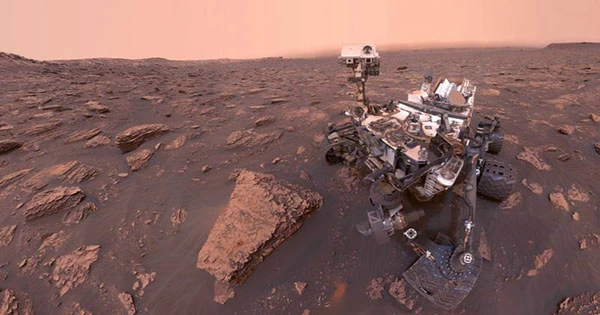The amazing scenery that the robotic population of Mars has uncovered on its journeys can’t help but leave you speechless. Certain characteristics of Mars, such as its blue sunset, are completely unfamiliar to us, but many others are. Some of the sights are too familiar, such as “snakes” in the rock formations and even balancing boulders. One of NASA’s Perseverance’s most recent photos provides a twofold geological curiosity for our enjoyment. It saw a little boulder standing on top of a much larger rock, like a cairn, and in the front, an eroded layered cliff with what seems to be a snake’s head.
The anaconda-like head wouldn’t be out of place amidst Cydonia’s “pyramids,” but it’s thousands of kilometers east. Perseverance has identified the formation as one of the most fundamental structures she has seen thus far. The stratified rocks date from when water flowed into Jezero crater, creating the river delta that the diligent robot is now researching in the hopes of discovering signs of previous life on Mars. The time has finally come. The Perseverance Mars rover is poised to begin researching its primary location: the delta of an ancient river that flowed into Jezero Crater billions of years ago.
Water-carved features on Mars are viewed as a good area for the search for ancient life on Mars, given how important water is to life on Earth. Within the next several sols, the rover will arrive at its first destination, Devils Tanyard. On Mars, a “sol” is a solar day that lasts roughly 40 minutes longer than an Earth day. The rest stop is on the road to Hawksbill Gap, which is located within the delta front. After Devils Tanyard, the crew hopes to make four more stops before arriving at Rocky Top, another interesting spot. This hike will take the rover through many rock strata that correlate to various stages in the development of these ancient geological formations.
“After we finish the first half of our walkabout, we’ll descend to three of our favorite places to sample.” “With these three sample pairs, the Perseverance team hopes to add to our Martian collectables a set of fine-grained clay-bearing mudstones that are good candidates for preserving organics and potential ancient microbes, as well as coarser grained sandstones to investigate material washed down from beyond Jezero and to constrain the timing of past lake activity,” wrote Brad Garczynski, a Purdue University student collaborator on the Perseverance team.
The fan-shaped delta that Perseverance is going to investigate is around 45 kilometers (28 miles) wide in Jezero Crater. Clays created when water was still running abound in the area, and the crater has been completely filled with sediments. “With each drive and sample, the crew learns more about this once-watery crater and pieces together the tale inscribed in the Martian rocks,” added Garczynski. Perseverance is equipped with a variety of equipment for studying materials on Mars, but it is also collecting samples that will be transported to Earth sometime in the next decade for further analysis.
















